Hitachi Deskstar 7K1000: Terabyte Storage arrives on the Desktop
by Gary Key on March 19, 2007 8:00 AM EST- Posted in
- Storage
PCMark05 Performance
We are utilizing the HDD test suite within PCMark05 for further comparative hard disk scores as it provides a mixture of actual application results and specific read/write percentages utilized within these programs. It is also a readily available benchmark that others can use for comparative purposes. The program utilizes the RankDisk application within the Intel iPeak SPT suite of tools to record a trace of disk activity during usage of real world applications. These traces are then replayed to generate performance measurements based upon the actual disk operations within each application. The HDD test suite contains 53% read and 47% write operations with each trace section utilizing varied amounts of read or write operations. Additional information about the test suite can be found in PDF format here PCMark05 whitepaper.
The PCMark05 test results are based upon the following trace runs:
Windows XP Startup: This test consists of 90% reading and 10% writes that tracks XP activities at start-up.
Application Loading: This test consists of 83% reading and 17% writes that tracks the opening and closing of the following programs.
File Write: This test consists of 100% write activities by writing 680MB of files onto the hard disk.
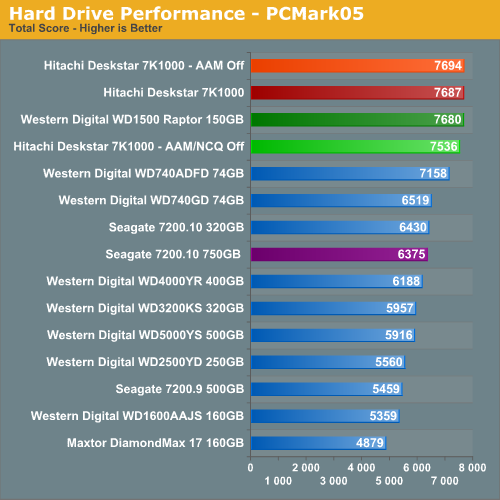
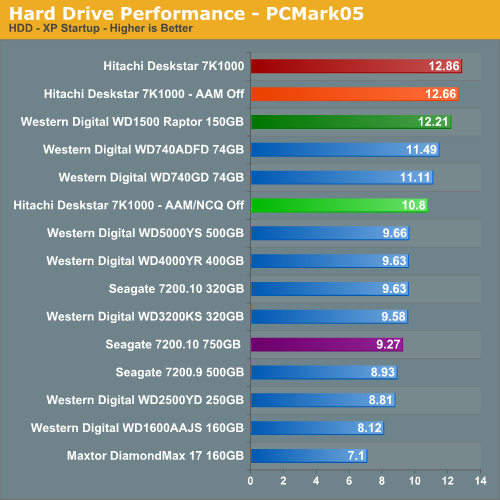

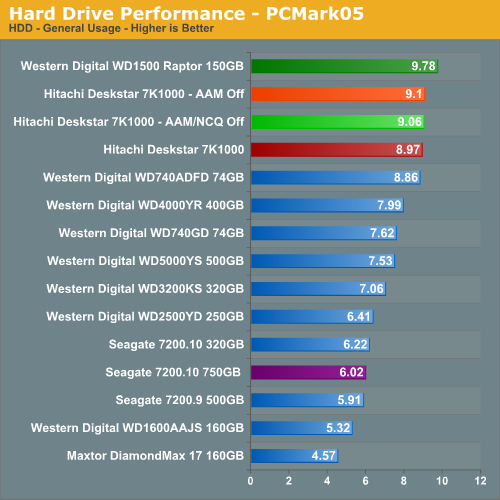
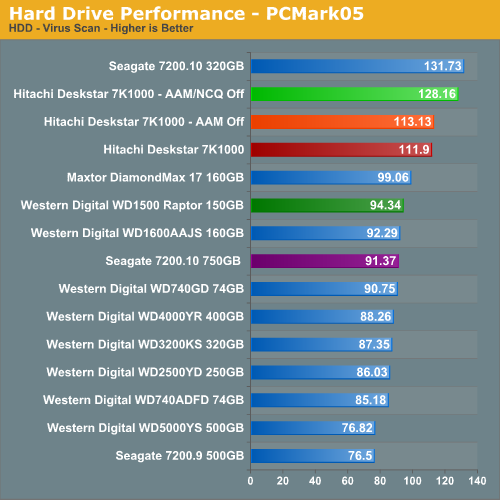
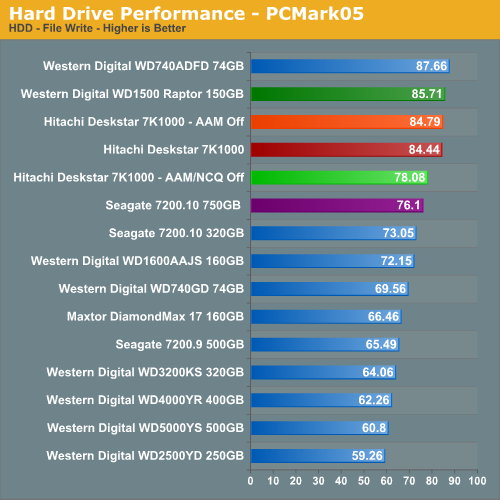
Our PCMark05 numbers surprised us with the 7K1000 scoring better than our previous champion, the WD 150GB Raptor. The performance delta between the 7K1000 and WD1500AHFD is minimal with the major differences occurring in the General Usage and Application sections of the test where combined write and read speeds favor the Raptor's rotational/access speeds while the 7K1000 scores extremely well in the Virus Scan tests especially when both AAM and NCQ are turned off.
We are providing test results with the 7K1000 in this series of benchmarks with AAM/NCQ on, AAM/NCQ off, and NCQ on only. The overall score goes to the NCQ only configuration but the AAM/NCQ on configuration only finishes 7 points behind. It was a toss up between the two configurations with the tests where read operations were prevalent benefiting the NCQ only setup. This is to be expected as random access times are about 30% slower with AAM on but it does not correlate to a noticeable difference in performance. This is one drive where you can have it quiet and fast at the same time. Our recommendation is to leave AAM and NCQ on unless you spend your day benchmarking virus scan programs.
We are utilizing the HDD test suite within PCMark05 for further comparative hard disk scores as it provides a mixture of actual application results and specific read/write percentages utilized within these programs. It is also a readily available benchmark that others can use for comparative purposes. The program utilizes the RankDisk application within the Intel iPeak SPT suite of tools to record a trace of disk activity during usage of real world applications. These traces are then replayed to generate performance measurements based upon the actual disk operations within each application. The HDD test suite contains 53% read and 47% write operations with each trace section utilizing varied amounts of read or write operations. Additional information about the test suite can be found in PDF format here PCMark05 whitepaper.
The PCMark05 test results are based upon the following trace runs:
Windows XP Startup: This test consists of 90% reading and 10% writes that tracks XP activities at start-up.
Application Loading: This test consists of 83% reading and 17% writes that tracks the opening and closing of the following programs.
- Microsoft Word
- Adobe Acrobat Reader
- Windows Media Player
- 3Dmark 2001SE
- Leadtek WinFast DVD
- Mozilla Internet Browser
- Opening a Microsoft Word document, performing grammar check, saving and closing
- Compression and decompression using WinZip
- Encrypting and decrypting a file using PowerCrypt
- Scanning files for viruses using F-Secure Antivirus
- Playing an MP3 file with Winamp
- Playing a WAV file with Winamp
- Playing a DivX video using the DivX codec and Windows Media Player
- Playing a WMV video file using Windows Media Player
- Viewing pictures using Windows Picture Viewer
- Browsing the Internet using Microsoft Internet Explorer
- Loading, playing and exiting a game with Tom Clancy's Ghost Recon
File Write: This test consists of 100% write activities by writing 680MB of files onto the hard disk.






Our PCMark05 numbers surprised us with the 7K1000 scoring better than our previous champion, the WD 150GB Raptor. The performance delta between the 7K1000 and WD1500AHFD is minimal with the major differences occurring in the General Usage and Application sections of the test where combined write and read speeds favor the Raptor's rotational/access speeds while the 7K1000 scores extremely well in the Virus Scan tests especially when both AAM and NCQ are turned off.
We are providing test results with the 7K1000 in this series of benchmarks with AAM/NCQ on, AAM/NCQ off, and NCQ on only. The overall score goes to the NCQ only configuration but the AAM/NCQ on configuration only finishes 7 points behind. It was a toss up between the two configurations with the tests where read operations were prevalent benefiting the NCQ only setup. This is to be expected as random access times are about 30% slower with AAM on but it does not correlate to a noticeable difference in performance. This is one drive where you can have it quiet and fast at the same time. Our recommendation is to leave AAM and NCQ on unless you spend your day benchmarking virus scan programs.










74 Comments
View All Comments
phusg - Tuesday, March 20, 2007 - link
I think you are right, but don't forget that in this post you are only looking at it from a performance viewpoint. Drive longevity and acoustics are major factors to me, and I think for you too from the article. I think these are the metrics worth looking at and tend to agree that subjective performance doesn't really differentiate that much (although I haven't had half as much experience with different vendors/models as you have).gramboh - Monday, March 19, 2007 - link
I read the review earlier this morning but don't recall seeing anything about retail channel availability. Did Hitachi or Dell comment to AT about this?I'm actually interested in 500GB 7200.10's and hoping this release will push the price of those down a lot.
Gary Key - Monday, March 19, 2007 - link
We do not have an exact date. Hitachi committed to having product into the retail channel by the end of Q1. We should have an answer from Dell tomorrow on when they will offer it outside of their systems. Hitachi is saying the drive will launch at $399, just waiting to see $550 price tags when the first drives show up... ;)Jeff7181 - Monday, March 19, 2007 - link
This might find it's way into my computer later this year. :)BUL - Monday, March 19, 2007 - link
Interesting that perpendicular technology was chosen given the R&D costs (with the tiny return of ~5 years before obsolescence--the article mentions that perpendicular can ONLY go 5x denser with existing techology & figure we'll see 5TB perpendicular drives in 2 years), etc... So why don't manufacturers offer 5 1/4" drives? Not to invoke memories of the MFM drives of long-ago (the original XT had a double-size 5 1/4" MFM drive of 10MB), but they have potentially 50-60% more surface area per platter, and with a possibility of 7(?) platters, isn't that a better solution? True, you wouldn't put them in SFFs or notebooks, but how many of us have towers with empty 5 1/4" bays??? And I assume that a 1TB 5 1/4" drive would be more energy-efficient than two 500GB 3 1/2" drives...Also, has anyone REALLY tested to see if perpendicular is truly a reliable technology? Seems like manufacturers have 50 years of experience with parallel storage, and only 1-2 years using perpendicular storage...
Spoelie - Tuesday, March 20, 2007 - link
Bulkier, slower, less energy efficient and more moving parts that reduce reliability all in the name of increased capacity is not the way to the future. I think the biggest problem at the moment is NOT storage capacity, they're mostly increasing capacity to keep HDs evolving and not drop in price, as it's one of the only competitive advantages. If you can increase capacity with the same material cost and some extra R&D, it would be stupid not to do it, and a better way than increasing the material cost.In fact, regular folk have way too much capacity at the moment. A Seagate CEO worded it nicely a while back "Face it, we're not changing the world. All we do is enable people to store more crap/porn."
The future lies in the direction of flash based hard drives: smaller, less/no moving parts instead of more, faster access times, lower energy consumption/heat. Or other alternative technologies that offer the same advantages. The densities and cost are the only reasons we're not all buying them at the moment, something that should be fixed over time.
If you're worried about unused case slots, buy one of those things that enable you to install normal hard drives in it, or convince the case designers to include more 3 1/2" slots and less 5 1/4" slots.
misuspita - Monday, March 19, 2007 - link
Have you ever seen a slow motion filming of a cd-rom disk wobbling? Same thing here! I think the platters got smaller because the vibrations produced by them grew with the speed. Since today's r/w heads need to be extremely close to the surface, that would be utterly impossible to control at that speed and diameter. They changed also from an aluminum based disk to an glass based one also, because the roughness of the surface on the Al platter.tygrus - Monday, March 19, 2007 - link
It's harder to spin a large diametter platter at high speed. More weight, more wobble, slower access times. I saw once a 5.25" 4x2.5" SATA drive array. Quantum used to do a large format BigFoot for cheap, slow large capacity but it wasn't continued. We have plenty of capacity per platter but limited perf/GB (worse every year) so why decrease performance to increase capacity ?piroroadkill - Monday, March 19, 2007 - link
All of the Seagate Barracuda 7200.10 drives have been perpendicular for some time..It seems like a perfectly reliable tech to me
Olaf van der Spek - Monday, March 19, 2007 - link
How smart is it to use temperatures from SMART?Did you verify all HDDs use good quality unbiased temperature sensors?
> Our thermal tests utilize sensor readings via the S.M.A.R.T. (Self-Monitoring, Analysis and Reporting Technology) capability of the drives and are reported by utilizing the Active SMART 2.42 utility.